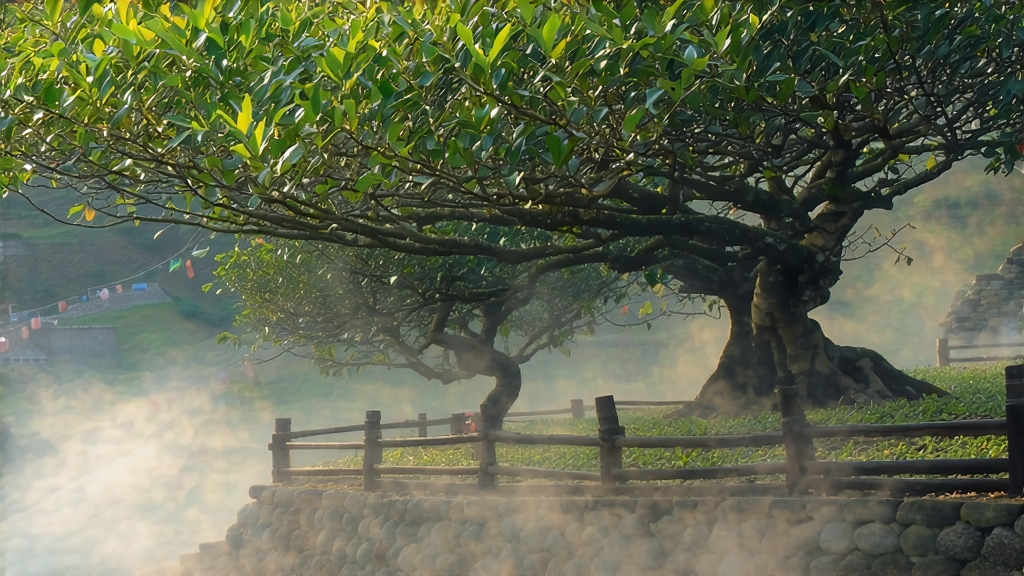
Hidden in the mist-veiled ridges of Phoenix Mountain in northern Guangdong Province, Phoenix Dancong—literally “single-bush”—is less a tea than a living archive of Chinese aromatic botany. For almost a thousand years, small communities of the She and Hakka peoples have coaxed from ancient feng huang (phoenix) tea trees liquors that taste of lychee, jasmine, almond, ginger flower, or wild honey, depending on which gnarled trunk you climb. International drinkers often meet Dancong through its most famous perfume, “Honey Orchid Fragrance” (Mi Lan Xiang), yet that cultivar is only one of dozens, each genetically distinct and named after the scent it is said to mimic. This essay invites you to walk the granite switchbacks above Wudong Village, inhale the charcoal smoke curling from 3 a.m. firerooms, and learn why a single cup can feel like sipping a Chinese garden at dusk.
History: From Song Dynasty Tribute to Global Geek Tea
The first written record appears in 1118 CE when Song Emperor Huizong accepted compressed Phoenix cakes as tribute, praising their “cooling throat and luminous liquor.” By the Ming, loose-leaf fashion reached the south coast; locals discovered that partial oxidation preserved the mountain’s heady florals while taming bitterness. Maritime trade carried Dancong to Southeast Asia where it became the breakfast tea of Hokkien gold-miners and, later, the secret darling of Hong Kong teahouses. Only since the 1990s, when air-travel allowed fresh arrivals to reach Berlin or San Francisco within 48 hours of firing, has Dancong entered the global specialty market. Today, pre-Qingming Wudong old-tree lots fetch prices rivaling top Burgundy crus, and Euro-centric auction houses list them simply as “Chinese aromatic oolong,” a phrase that barely hints at the biodiversity inside each vacuum-sealed bag.
Terroir and Botanic Diversity
Phoenix Mountain is a 1,500-meter granite spine punched through by subtropical storms. Diurnal swings of 15 °C coax slow growth; thin, mineral-rich soils force roots to dive three meters, absorbing potassium and selenium that translate into cup sweetness. Unlike the clonal terraces of Anxi or Wuyi, Dancong gardens are forests: 30- to 600-year-old tea trees spaced among persimmon, wild pear, and ferns. Over centuries, farmers selected individual trees whose leaves naturally evoked familiar aromas—an evolutionary dialogue between human palate and plant chemistry. Recent DNA bar-coding at South China Agricultural University identified 52 distinct cultivars; the most prized thrive above 800 m in the Wudong core, where morning clouds act as a natural shade cloth, increasing theanine and floral volatiles.
Craft: The Dance of Sun, Wind, and Charcoal
Dancong production follows the traditional Lingnan oolong protocol—withering, bruising, brief oxidation, fixation, rolling, baking—but with mountain-specific subtleties that read like choreography.
- Outdoor Withering: Leaves are spread on bamboo screens within 30 minutes of plucking. The high-mountain sun is gentle before 10 a.m.; growers flip leaves every 20 minutes to ensure even moisture loss while preserving the signature “green in the center, red on the edge” look.
- Night Bruising: After sunset, humidity rises; trays are stacked to encourage enzymatic browning. Experienced artisans listen for a faint rustle—when the leaf edge fractures but midrib remains elastic, oxidation is arrested.
- Charcoal Baking: The soul of Dancong lies in the firing room. A sunken pit of 荔枝木 (lychee wood) charcoal maintains 75 °C for 8–12 hours, repeated up to three times over six weeks. Between bakes, the tea rests in unglazed clay urns, allowing moisture to migrate from core to surface, refining aroma and adding a whisper of smoked caramel.
- Single-Tree Craft: For top lots, each tree is harvested and processed separately. A 300-year-old “Song Zhong” might yield only 1.2 kg finished tea; its leaves are so tender that bruising is done by hand tossing inside a hemp sack rather than mechanical tumblers, preventing premature tearing.
Varietal Aromas: A Lexicon of Scent
Chinese cuppers describe Dancong aromas through the term 香型 (xiang xing), “fragrance type.” While Western flavor wheels lean on